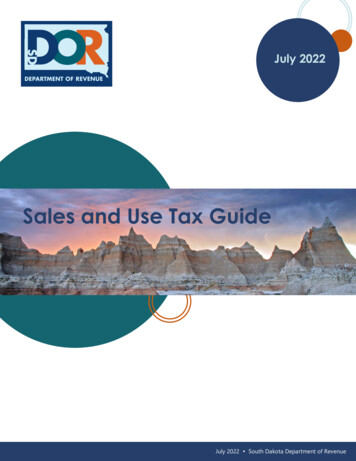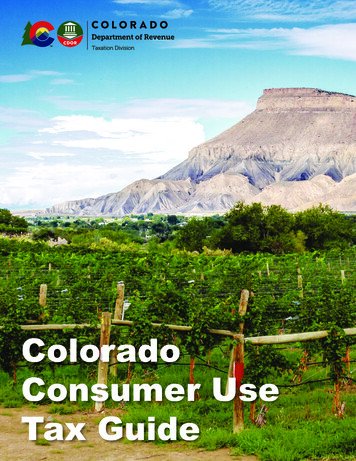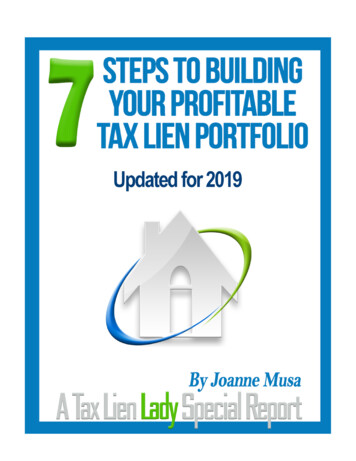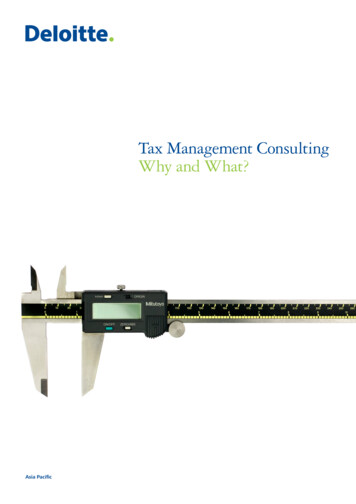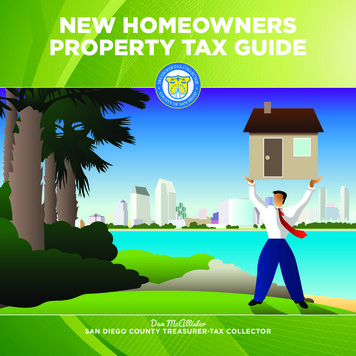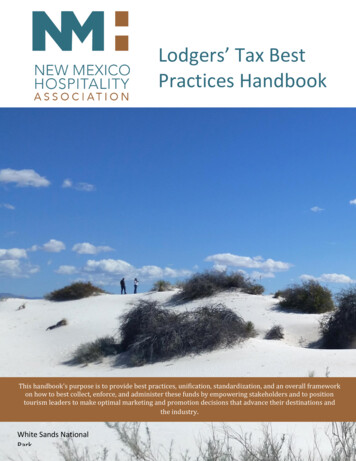
Transcription
Lodgers’ Tax BestPractices HandbookThis handbook’s purpose is to provide best practices, unification, standardization, and an overall frameworkon how to best collect, enforce, and administer these funds by empowering stakeholders and to positiontourism leaders to make optimal marketing and promotion decisions that advance their destinations andthe industry.White Sands NationalParkPage 0 of 41
TABLE OF CONTENTS —1. Executive Summarya. Purposeb. Guiding Principalsc. Development Process2. The Path of Lodgers’ Taxa. Collection: Lodging Businessesb. Submission: NM Department of Finance Administration (DFA) — Local Government Divisionc. Governance & Administration: Local Governmentsi. Calculating How Lodgers’ Tax Can Be Spentii. Other Allowable Uses of Lodgers’ Tax Proceedsiii. Accountabilityd. Oversight & Transparency: Lodgers’ Tax Advisory Boardse. Disbursement: Lodgers’ Tax Funds Administratorsi. Industry Statistics to Have on Handii. Determination of Applicable Use & Funding Requests1. Understand Use Provisions2. Understand Other Definitions3. Develop a Strategic Process for Funds Use4. Statutory Requirements & Best Practice Recommendationsiii. Measure the Return on Investment & Economic Impact3. Additional Stakeholders4. Additional Tourism Development Financing Mechanisms5. Overview of the Short-term Rental Marketa.b.c.Creating Effective Short-term Rental Policiesi. Assessmentii. Policy Objectivesiii. Regulatory ApproachesMonitoring, Compliance & EnforcementResources6. Descriptions & Definitions7. Resource AppendixDisclaimer StatementThe information provided in this document does not, and is not intended to, constitute legal advice. Allinformation, content, and materials referenced in this document are for general informational purposes onlyand should not be considered legal advice of any kind. Readers of this document should contact an individualattorney to obtain advice with respect to any particular legal matter related to the New Mexico Tax Code orany local Lodgers' Tax statutes. No reader or user of this document should act or refrain from acting on thebasis of information contained in the document. Only your individual attorney can provide assurances thatthe information contained herein — and your interpretation of it — is applicable or appropriate to yourPage 1 of 41particular situation. Use of this document, or any of the resources contained herein, does not create anattorney-client relationship between the reader or user and the NMHA. References are provided forinformational purposes only and are subject to change at the discretion of NMHA. The information containedin this document is also subject to changes based on legislative action.
Executive Summary:Hospitality and tourism is a leading economic driver for the State of New Mexico (second only to oil/gas)contributing 693 million in state and local tax revenue in 2018. Tourism had its largest economic impact instate history for a seventh straight year, injecting 7.1 billion into New Mexico’s economy and supportingnearly 102,000 jobs in 2019. 1–in–12 New Mexico jobs are supported by visitor spending and tourismsustained 8.5% of all jobs in 2018 (source: NMTD Annual Report—2018).Due to the importance and impact of tourism to New Mexico’s economy, it is critical that tourism funding isused the way it was intended. To continue to attract visitors to New Mexico, effective marketing andpromotion is necessary. Lodgers’ Tax is a crucial funding mechanism that allows local municipalities tofurther promote their destinations and drive visitation to their tourism economies.The Lodger’s Tax Best Practices Handbook was designed with six stakeholdergroups in mind, with each having an essential role in the collection,enforcement, and administration of Lodgers’ Tax.1.2.3.4.5.6.Lodging BusinessesLocal GovernmentDestination Marketing Organization (DMO) /Lodgers’ Tax AdministratorsLodgers’ Tax Advisory BoardsEvent OrganizersNew Mexico Department of Finance Administration — Local Government DivisionPurpose of This Handbook:This handbook’s’ purpose is to provide best practices, unification, standardization, and an overall frameworkon how to best collect, enforce, and administer these funds to grow the tourism economy by providingguidance and empowering stakeholders and to position tourism leaders to make optimal marketing andpromotion decisions that advance their destinations and the industry.Furthermore, the state Lodgers’ Tax statute (also referred to as Occupancy Tax) was established in 1969 forthe purpose of allowing municipalities the option to create local Lodgers’ Tax ordinances to collect tax forthe primary purpose of marketing and promoting their destination to tourists. The local ordinances andadministration of the Lodgers’ Tax must be executed within the context of the state statute. Lodgers’ Tax isan international funding model that has successfully increased tourism and furthered local tourismeconomies.www.newmexicohospitality.org - Lodgers’ Tax Manual Resources – Lodgers’ Tax StatuteGuiding Principles 1.2.3.4.Sharply focus on the ultimate intent of Lodgers’ Tax which is to grow the tourism economyGrow tourism through promotion and developmentIncrease tourism employmentNurture fiscal stewardshipPage 2 of 41
Hospitality and tourismcontributed 693 millionin state and local taxrevenue in 2018.Page 3 of 41Ski New Mexico
Development Process:New Mexico Hospitality Association led three phases of development for the Lodgers’ Tax Best PracticesHandbook.PhaseOne Industry Survey Industry Roundtables Convene Task ForcePhaseTwo Membership Feedback on Draft State and National StakeholderFeedback on DraftPhaseThree Membership Approval Stakeholder Endorsements PublishIn the fall of 2019, NMHA conducted a survey of statewide municipalities and counties administration ofLodgers’ Tax. The results clearly illustrated the common challenges throughout the state, and the feedbackfrom the tourism industry affirmed the need for a comprehensive Lodgers’ Tax resource that addressed theindustry’s needs: To establish uniformity and standardization criteria for collection, expenditure, and administrativepractices;To compile resources to provide guidance;To provide guidance on the technological advancements that have created disrupters and/or alteredthe tourism industry as well as the marketing/promotion industry; andTo provide guidance on the online booking platforms, online marketplace platforms and/or shortterm rental markets, as commonly termed, that are now a major global tourism player. Theseproperties have historically and largely operated with very little oversight, creating a lack of paritywith traditional lodging businesses.The remaining information, resources and guidance that follows, aligns with the Path of Lodgers’ Tax Fundsgraphic on the next page. This is designed for the purpose of simplicity and flows with the Lodgers’ Taxstatute from a process standpoint.Page 4 of 41
Page 5 of 41
Path of Lodgers’ Tax Funds:Collection, administration, and enforcement are the three general aspects relating to Lodgers’ Tax andunderstanding the various roles of stakeholder groups, lends itself to these best practices.COLLECTION: Lodging BusinessesLodging Businesses are entities engaged in providing overnight accommodations andservices to tourists. Be aware of state and local ordinances affecting your business. Lodger’s Tax is to be collected for each night of a stay of 30 days or less andon days 1 through 30 of an extended stay.Report Lodgers’ Tax to your local Lodgers’ Tax Administrator.Be prepared for an annual audit by your local government.Make sure the industry is actively represented on the Lodgers’ Tax Advisory Board.Hold your community accountable for how they invest Lodgers’ Tax Monitor reports and advocate local governments to ensure Lodgers’ Tax is used forintended purposes and hold municipalities, administrators, and event organizersaccountable for resultsSUBMISSION OF REPORTS: New MexicoDepartment of Finance Administration —Local Government DivisionCollects and posts Lodgers’ Tax as reported by local municipalities. Reports are due from local governmentsto DFA – Local Government Division, within 30 days following the quarter ending report. Example: Fiscalyear Q1 (July-Sept) revenue and expense activity report is due to DFA-LGD by October uant to Statute 3-38-15D(2), this formula applies to a municipality not located in a class A county, or acounty which is not a class A county, that is imposing an occupancy tax of more than 2%.http://www.nmdfa.state.nm.us/County cial Distribution.aspxPage 6 of 41
GOVERNANCE & ADMINISTRATION OFFUNDS: Local GovernmentsFor these purposes, Local Governments are defined as elective and appointiveentities and agencies in political geographic areas (counties or municipalities) that regulate and administeractivities engaged in lodging, services, and products provided to tourists. In fiscal year 2018, New MexicoLodgers’ Tax was over 53,000,000 according to New Mexico’s Department of Finance Administration —Local Government Division. Every local governing body must ensure their Lodgers’ Tax Code/Ordinance/ Resolution is up to datewith the current Statute.The local ordinance should include, at minimum: Definitions Declaration of % to be collected based on the size of the community (See Figure #1) Requirements for collecting tax from lodgers Requirements for quarterly reporting Policy and Procedures on how funds will be used Policy and Procedures on how ordinance will be enforcedShort-term rental platforms are now required to pay Lodgers’ Tax — this is outlined in PART 2.In 2019, Senate Bill 106 (SB106) was passed, removing the 3-room exemption and making it easierfor communities to track short-term/vacation rentals and collect applicable taxes.https://legiscan.com/NM/bill/SB106/2019In 2020 House Bill 117 (HB117) was passed, amending the Act to alter certain exemptions andchanging the allowable uses of occupancy tax revenue to allow some communities to extendLodgers’ Tax to rentals longer than 30 days. https://legiscan.com/NM/bill/HB117/2020Calculating How Lodgers’ Tax Funds Can Be Spent (Restrictions) New Mexico’s Lodgers’ Tax Act has a very specific formula to determine the absolute minimum amount ofLodgers’ Tax proceeds that must be spent on marketing and promotion. There are other restrictions for theremaining proceeds; however, all Lodgers’ Tax proceeds must be used with the intent to grow the tourismeconomy. This formula is outlined in section 3-38-15-D of the Lodgers’ Tax Act or check chapter-3/article-38/section-3-38-15/Dependent upon the city’s or county’s classification, there are different requirements for the percent offunds that must be used for marketing and promotion. To determine a municipality’s restrictions and/orconfirm a city and/or county’s classification see Figure #2. The flowchart illustrates how to calculate theLodgers’ Tax restriction rate.*Examples for all items can be found in the Resource Appendix on Page 37.Page 7 of 41
Figure #1: Lodgers’ Tax Rates for New MexicoMunicipalities & CountiesPage 8 of 41
Figure #2: Lodgers’ Tax Restriction Rate Formula and FlowchartIs the tax ratemore than 2%?YesNoAt least 1/4 ofproceeds must befor marketing.Class A County?YesNo 100,000*1/4 25,000At least 1/2 ofproceeds must befor marketing. 100,000*1/2 50,000FORMULA: [(3% / tax rate) *proceeds] * ½ [(tax rate – 3%)* proceeds * ¼] minimumamount of lodgers’ tax proceedsto be spent onmarketing/promotion.Is the tax ratemore than 3%?YesNoAt least 1/2 ofproceeds of 1st3% must be formarketing.At least 1/2 ofproceeds must befor marketing.At least 1/4 ofproceeds in excess of3% must be formarketing. 100,000 * 1/2 50,000See "the formula"After calculating the absolute minimum amount of Lodgers’ Tax proceeds that must be spent on marketingand promotion, it is important to note that spending as much Lodgers’ Tax funds as possible on marketingand promotion is most beneficial to grow tourism, increase visitation, increase visitor spend and create jobs.Page 9 of 41Sunrise Springs Spa Resort
Other Allowable Uses of Lodgers’ Tax Proceeds The statute recognizes that there are costs associated with the collection, administration, and managementof the Lodgers’ Tax process as well as the creation and maintenance of the tourism infrastructure.Accordingly, subject to the limitations contained in Section 3-38-15 NMSA 1978 a municipality or countyimposing a Lodgers’ Tax may, once the required minimum amount of Lodgers’ Tax proceeds that must bespent on marketing and promotion has been met, use the proceeds from Lodgers’ Tax to defray costs apter-3/article-38/section-3-38-15/ Collecting and otherwise administering the occupancy tax, including the performance of auditsrequired by the Lodgers’ Tax Act pursuant to guidelines issued by the Department of Finance &Administration – Local Government Division; Establishing, operating, purchasing, constructing, otherwise acquiring, reconstructing, extending,improving, equipping, furnishing or acquiring real property or any interest in real property for thesite or grounds for tourist-related facilities and attractions or tourist-related transportation systemsof the municipality or the county in which the municipality is located; The principal of and interest on any prior redemption premiums due in connection with and anyother charges pertaining to revenue bonds authorized by Section 3-38-23 or 3-38-24 NMSA tion3/38-24/ Providing police and fire protection and sanitation service for tourist-related facilities, attractionsand events located in the respective municipality or county; Providing a required minimum revenue guarantee for air service to the municipality or county toincrease the ability of tourists to easily access the municipality's or county's tourist-related facilities,attractions and events; or Contracting for the management of programs and activities funded with revenue from the Lodgers’Tax (Section 3-38-21 NMSA 1978 - jd 3-3821-26ab.html). Funds provided to the contracting person or governmental agency shall bemaintained in a separate account established for that purpose and shall not be commingled withany other money. The contractor may spend Lodgers’ Tax funds on day-to-day operations, supplies,salaries, office rental, travel expenses and other administrative costs only if those administrativecosts are incurred directly for the purpose of managing the programs and activities funded withrevenue from the Lodgers’ Tax. Any combination of the foregoing purposes or transactions stated in this section, but for no othermunicipal or county purpose.Page 10 of 41
Exemptions (Cannot Tax) The Lodgers’ Tax does not apply in the following situations: If a renter/vendee is using the premises as their permanent residence of over thirty (30) days and hasentered into a written agreement for use of the taxable premises;If the rent paid by a vendee is less than two dollars ( 2.00) per day;Lodging accommodations at institutions of the federal government, the state or any political subdivisionthereof;Lodging accommodations at religious, charitable, educational or philanthropic institutions, includingaccommodations at summer camps operated by such institutions;Clinics, hospitals or other medical facilities; orPrivately owned and operated convalescent homes or homes for the aged, infirm, indigent or chronicallyill.Vendor & Municipality Accountability:Vendor Accountability –Per the Lodgers’ Tax Statute, every vendor providing lodging within a county or municipality that imposes alodgers’ tax is responsible for collecting and reporting that tax. If the county or municipality collects morethan 250,000 in lodgers’ tax revenue, the governing body must conduct random audits of vendors toconfirm compliance. The audit requirements are to be outlined in the local Lodgers’ Tax ordinance (3.38.20)and should specify: the times, place and method for the payment of the occupancy tax proceeds to the municipality orcounty;the accounts and other records to be maintained in connection with the occupancy tax;a procedure for making refunds and resolving disputes relating to the occupancy tax, includingexemptions pertaining thereto;the procedure for preservation and destruction of records and their inspection and investigation;vendor audit requirements;applicable civil and criminal penalties; anda procedure of liens, distraint and sales to satisfy such ipalities/nm-st-sect-3-38-20.html*Note: Most local ordinances include confidentiality language regarding the results of Lodgers’ Tax Audits.( Sample language — It is unlawful for any employee of the City to reveal to any individual, other thananother employee of the City, any information contained in the return or audit of any taxpayer, includingvendors subject to the Lodgers' Tax Act, except to a court of competent jurisdiction in response to an orderthereof in an action related to taxes to which the City is a party, and in which information sought is materialto the inquiry; to the taxpayer himself or to his authorized representative; and in such manner, for statisticalpurpose, the information revealed is not identified as applicable to any individual taxpayer.)Page 11 of 41
Municipality Accountability –As previously mentioned, every municipality is required to file Lodgers’ Tax reports with DFA – LocalGovernment Division. Lodgers’ Tax Reports can be accessed at:http://www.nmdfa.state.nm.us/Financial Distribution.aspxEvery municipality is also required to have an annual audit. The Office of the State Auditor in accordancewith the Audit Act, §§12-6-1 to 12-6-14, NMSA 1978, is tasked with thoroughly examining andauditing the financial affairs of every agency and political subdivision of the state that receives or expendspublic money from whatever source derived, including counties and municipalities.Annual audit reports can be viewed at: /Moreover, the Office of the State Auditor maintains a hotline that allows the public to report allegationsfinancial fraud, waste or abuse. This tool allows individuals to report 24 hours a day, sevendays a week either on the record or anonymously. Reports may be made /en/gui/58852/index.html or by calling 1-866-OSA-FRAUD(1-866-672-3728).OVERSIGHT & TRANSPARENCY:Lodgers’ Tax Advisory BoardsAs outlined in the Lodgers’ Tax Act [3-38-13 through 3-38-24 NMSA 1978], themayor or county commission chair of every municipality or county thatimposes an occupancy tax shall appoint a five-member advisory board thatconsists of: Two members who are owners or operators of lodgings subject tothe Occupancy Tax within the municipality or county,Two members who are owners or operators of industries located within the municipality or countythat primarily provide services or products to tourists; andOne member who is a resident of the municipality and represents the general public.The advisory board’s Involvement may vary depending on the nature of each community or county tourismmanagement structure; however typically the advisory board shall: Advise the respective governing bodies on the expenditure of funds authorized by Section 3-38-15NMSA 1978 for advertising, publicizing and promoting tourist attractions and facilities in therespective counties and municipalities; andSubmit to the mayor and council or county commission recommendations for the expenditures offunds authorized pursuant to the Lodgers’ Tax Act for advertising, publicizing and promoting touristrelated attractions, facilities and events in the respective counties and municipalities.Lodgers’ Tax Advisory Boards are subject to the New Mexico Open Meetings nce%20Guide%202015.pdfPage 12 of 41
For detailed information on a municipality’s Lodgers’ Tax Advisory Board, you can research the codifiedordinances for that particular community or county — the clerk, general counsel or executive leadership ofthe community or county are also good resources.DISBURSEMENT:Lodgers’ Tax AdministratorsDestination Marketing Organizations (DMO) (sometimes known as Convention VisitorsBureaus or CVBs) promote the long-term development and marketing of the destination,serving those attractions and activities of tourist related services and products for thepurpose of driving visitation to that destination. Chambers of Commerce in communities without a DMO orCVB, may serve in that capacity as might Event Organizers contracted to organize, promote and operatefairs, festivals, meetings and conferences and other group events which draw visitors and tourism to thedestination.BEST PRACTICE:Industry Statistics to AlwaysHave on HandKnowing that differing interpretations of existing law and/or a lack of awareness of Lodgers’ Taxrequirements can occur when new leadership comes on board, which can be new elected officials, newLodgers’ Tax Advisory Board members, or a new Municipal Administrator, it is important to be proactive ineducating and communicating the value, importance, process and policy — data and statistics are effectivetalking points and can be used to gain support. Consider having on hand current information specific to thecommunity or county that highlights areas such as: the economic impact of the hotel/tourism industry on the State's economy and on your specific cityor region;employment numbers by the visitor industry-hotels, restaurants, bars, retail, transportation,amusement and recreation sectors;where visitors stay (with friends and relatives, in short- term rentals, at hotels, in apartments, etc.)what visitors spend on transportation, retail, lodging, meals, etc.;occupancy, average daily rate, and actual demand history for your community;any other numerical support for the statistics from other credible sources; andportray this information on a pie chart to show that there are many others and larger beneficiariesof the tourist dollar DISBURSEMENT: Determination of ApplicableUse & Funding RequestsWhile all Lodgers’ Tax funds are intended to support tourism growth with an emphasis on increasingday trips and marketable overnight visits, there is a portion of the proceeds that are required to beused to specifically advertise, publicize and promote tourist-related attractions, facilities and eventswhich is calculated using the provided formula on page 9. The remaining funds may be utilized forPage 13 of 41
several tourism related expenditures with the intent to increase Day Trips and Marketable r-3-municipalities/nm-st-sect-3-38-15.htmlSTEP ONE: Understand the use provisions:Component #1: Define “tourism related events”“Tourism-related events” means events that are planned for, promoted to and attended by ponent #2: Define the term ‘tourist.’“Tourist” means a person who travels for the purpose of business, pleasure or culture to a municipalityor county imposing an occupancy tax -municipalities/nm-st-sect-3-38-14.html The key word is travel and New Mexico Tourism Department best practices define a tourist as “onethat travels *60 miles or more from their residence”*Note that 60 miles is the preferred standard, but in rural New Mexico that is not alwaysapplicable.Component #3: Define “planned for, promoted to, and attended by” The term “planned for” suggests that the event must be specifically produced with the intent toattract tourists. This component of the definition will quickly disqualify many events that areproduced for the citizens of a municipality.The term “promoted to” suggests that the event must be promoted specifically to tourists. To beconsidered a tourist, a person must travel for the purpose of business, pleasure or culture;therefore, the event must be promoted outside of the given municipality where the event is to belocated, which means the media purchased must target media markets outside of the municipality.Best practices suggest that the event should be promoted outside at least a 60-mile radius.The term “attended by” suggests that tourists must actually be at the event to qualify as a tourismrelated event. It is critical to track where event attendees are from so event planners and Lodgers’Tax administrators know if tourists actually attended the event.Component #4: Statutory Definition of “tourism-related facilities and attractions”“tourist-related facilities and attractions” means facilities and attractions that are intended to be used byor visited by tourists municipalities/nm-st-sect-3-38-14.htmlCommon examples include natural and cultural sites, historical places, monuments, zoos and gamereserves, aquaria, museums and art galleries, gardens, architectural structures, theme parks, sportsfacilities, festivals and events, and wildlife.Page 14 of 41
STEP TWO: Understand other definitions for use provisionsWhile the Lodgers’ Tax Statute does not define all terms and terminology, it is important to utilize standarddefinitions when evaluating Lodgers’ Tax requests and determining the use of Lodgers’ Tax funds. Somestandard terms include: MarketingAdvertisingPublicizingPromotionMarketable Overnight TripsThese terms are defined in the Definitions Section beginning on Page 34. (Definition Sources: AmericanMarketing Association, US Travel Association, UNWTO – United Nations World Tourism Organization).STEP THREE: Develop a strategic process for funds useTIPSIdentify ways for the project to produceor convert visitation into “heads inbeds”. Include or request a plan that setsa goal to ensure a percentage of visitorsstay at lodging properties that collectlodgers’ taxConsider the development of a community marketingstrategy or tourism development strategy so that allrequests roll up to the overall goals and objectives.Consider involving the lodging propertiesfor rate and occupancy benefits duringshoulder or peak seasons.Identify and require each project to outline the priorityto reach visitors in specific markets and that theapproach meets the 60-mile radius thresholdIdentify the planned promotionalactivities (type of media, geographicreach of media, special publications)Leverage additional community support that meets theprojects needs while at the same time pledges aportion of lodgers’ tax funds (in-kind,business/corporate support, etc.)Page 15 of 41
Present information in a consistentfashion — ensure data listed in one areaof an application matches otherreferencesConsider hosting a workshop to explain lodgers’ tax asan economic driver to stakeholders and lodgers’ taxfund requestors so they understand the standardizedprocess. Other workshops can be held to educate onwho should be paying lodgers’ tax and what it does.Establish methods for trackingattendance, lodging, and other data.(Samples are provided in the ResourceAppendix)Make sure the economic impact figures are accurateand have data to reinforce. Develop or utilize animpact analysis sheet.(A sample is provided in the Resource Appendix)Establish methods to evaluate programsuccess to quantify and quality Return onInvestment (ROI) and/or EconomicImpact.Make sure you demonstrate how your project servesthe community brandPage 16 of 41
STEP FOUR: Consider these Statutory Requirements and BestPractice RecommendationsDebt service forconventioncentersAdvertising, publicizing, andpromoting events, facilities,and tourist attractions thatdraw visitors from at least a60 mile radius; acquiring,constructing, andmaintaining touristattractions and recreationalfacilitiesMarketing and/oroperations ofconvention centersVisitors’CentersExpenses related tothe administration ofLodgers’ Tax fundsDestination MarketingOrganizations and/orChambers ofCommerceEventCentersCultural facilities,nonprofits,cultural artsTransit, solid waste,police and fire safetyovertime in support oftourism activitySpecial Events thatplace “heads inbeds”Special useallocations formarketingPage 17 of 41
Acceptable Advertising Uses ofLodgers TaxA wine festival that promotes the event tothe defined tourist and is attended bythe defined tourist (outside a 60-mile radius).Alternative UsesUtilization of Lodgers’ Tax to sponsor a WeddingExpo where hotels and other wedding vendorsparticipate in a trade show and the localcommunity attends to seek out their favoritevendors for their upcoming wedding.A marketing campaign to promote acommunity asset or event, with a direct focuson a specific drive or fly market audience, thathas an overnight stay (or multiple) component,and an ancillary spend component.A marketing campaign for niche printpublications or to enthusiasts, such as RV’ers,to visit a destination or attend an event thatdoes is either not a high valued traveler,and/or does not have a conversion factor:overnight lodgingPrint, digital, social, and out of home mediauses. Media buy in a targeted drive market inanother state. The media buy is to promotedestination (i.e. street car wrap, trolley signage)A marketing or promotion campaign toutingassets that limits the travelers experience to onlya day trip.Travel and Adventure Tradeshow branded boothsignage or shows in target market that consumersare attending. The ROI is
Lodger's Tax is to be collected for each night of a stay of 30 days or less and on days 1 through 30 of an extended stay. Report Lodgers' Tax to your local Lodgers' Tax Administrator. Be prepared for an annual audit by your local government. Make sure the industry is actively represented on the Lodgers' Tax Advisory oard.


